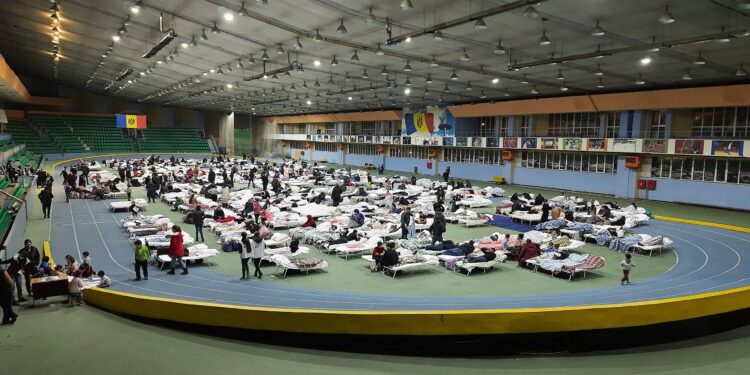Russia’s invasion of Ukraine has spawned Europe’s biggest refugee crisis since World War II. According to the United Nations High Commissioner for Refugees, almost eight million Ukrainian refugees have been recorded in Europe and other neighbouring countries, with an additional 250,000 having left for North America.
Ukraine’s pre-war population (excluding Crimea) was estimated to be around 41 million, which means that almost one in five Ukrainians have left the country. An additional fraction of the population has been internally displaced.
Because men are banned from leaving, at least 85% of those who’ve fled are women. (Depending on how many eventually return, this could dramatically upset the country’s gender balance.)
Scanning the numbers of Ukrainian refugees recorded in different countries around the world, one figure stands out – the number recorded in Russia. According to the UNHCR, 2.85 million refugees are residing there, more than in any other country. Indeed, 2.85 million is almost 36% of the total number of Ukrainian refugees.
At first glance, the fact that such a large number of Ukrainians have fled to Russia would seem to support Putin’s claims about the persecution of ethnic Russians in eastern Ukraine. At the very least, it would seem to undermine the Western narrative that Ukrainians are united in wanting to join the West.
Indeed, 36% is similar to the proportion of Ukrainians who favoured joining the Russian-led Eurasian Customs Union, rather than the European Union, in polls taken before the ‘Revolution of Dignity’. For example, in September of 2013, 37% said they favoured the Eurasian Customs Union, versus 42% who said they favoured the EU.
Yet the number of refugees in Russia can’t be taken at face value. Western sources claim that many Ukrainians residing in Russia were sent there involuntarily. Last July, U.S. Secretary of State Anthony Blinken stated that “Russian authorities have interrogated, detained, forcibly deported between 900,000 and 1.6 million Ukrainian citizens”.
This allegation was repeated by America’s ambassador to the UN, Linda Thomas-Greenfield. Russia dismissed it as a “fantasy”.
In her speech, the U.S. ambassador referred to evidence gathered by Human Rights Watch, the Organisation for Security and Cooperation in Europe and the Yale School of Public Health’s Humanitarian Research Lab – each of which has investigated allegations of forced deportations by Russian authorities. (The Associated Press has also looked into such allegations.)
The investigation by Human Rights Watch is the most extensive. They interviewed several dozen Ukrainians, and concluded that “most of the cases” they documented “amount to forcible transfers” and potentially, therefore, war crimes.
However, what’s not clear is how representative these cases are. The number of Ukrainians interviewed by HRW is a tiny percentage of 2.85 million, and the cases are unlikely to have been selected at random. This isn’t necessarily a failing of HRW; gathering reliable information on refugees is difficult, especially in the middle of a war.
Indeed, the organisation states that “the total number of Ukrainian civilians transferred to Russia – either voluntarily or involuntarily – remains unclear”. And to my knowledge, U.S. officials have not explained how they obtained the figure of “between 900,000 and 1.6 million” deported Ukrainians.
In September, the UN’s Assistant Secretary-General for Human Rights stated that “in the cases documented by the OHCHR” Ukrainians transferred to Russia “have had freedom of movement”. Which is consistent with HRW’s finding that “all 18 people” they interviewed who went to Russia subsequently left. (HRW interviewed 54 Ukrainians who either went to Russia, went through Russian ‘filtration’, knew people who went there, or helped people leave Russia; of these, 18 went to Russia.)
However, the Assistant Secretary-General did also refer to “credible allegations of forced transfers of unaccompanied children” – transfers that may involve illegal changes to children’s personal status, including nationality. Russia, again, denied these allegations.
While Ukrainians in Russia are “technically free to leave”, the Associated Press reports, many fear that “if they return, Ukraine will prosecute them for going to the enemy” – a fear that is “encouraged by Russian officials”. Others lack the money or documents needed to travel long distances.
Another point worth noting is that the figure of 2.85 million Ukrainian refugees in Russia may itself be inflated. This was the conclusion of the University of Texas Global Disinformation Lab, after they analysed satellite imagery of crossings at the Russia-Ukraine border.
At the present time, we don’t know how many Ukrainians were forcibly transferred to Russia. While there’s evidence that the number is greater than zero, very high estimates put forward by U.S. officials have not been independently verified.
Many of those sent to Russia involuntarily have been able to leave (albeit without any support from Russian authorities) which suggests the stock of Ukrainian refugees in Russia may comprise a large number of individuals who are residing there voluntarily. On the other hand, some may have stayed due to practical constraints.













To join in with the discussion please make a donation to The Daily Sceptic.
Profanity and abuse will be removed and may lead to a permanent ban.